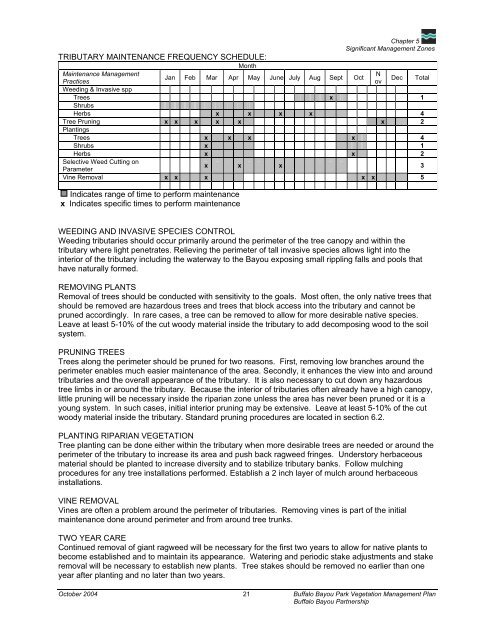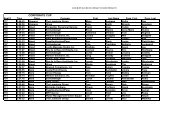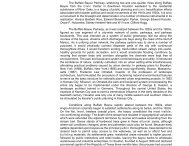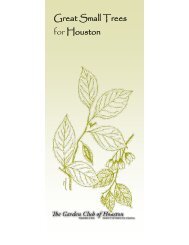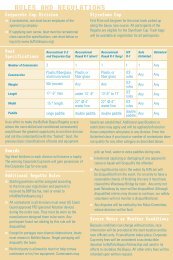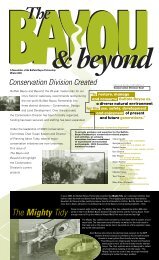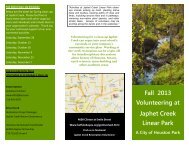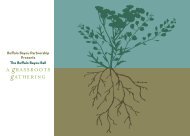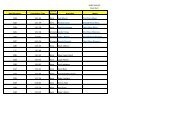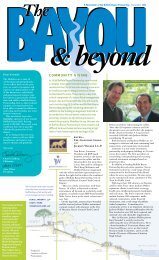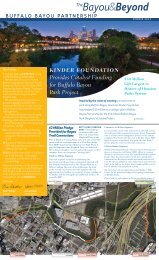Buffalo Bayou Park Vegetation Management Plan (PDF)
Buffalo Bayou Park Vegetation Management Plan (PDF)
Buffalo Bayou Park Vegetation Management Plan (PDF)
Create successful ePaper yourself
Turn your PDF publications into a flip-book with our unique Google optimized e-Paper software.
TRIBUTARY MAINTENANCE FREQUENCY SCHEDULE:MonthChapter 5Significant <strong>Management</strong> ZonesMaintenance <strong>Management</strong>NJan Feb Mar Apr May June July Aug Sept OctPracticesovDec TotalWeeding & Invasive sppTrees x 1ShrubsHerbs x x x x 4Tree Pruning x x x x x x 2<strong>Plan</strong>tingsTrees x x x x 4Shrubs x 1Herbs x x 2Selective Weed Cutting onParameterx x x 3Vine Removal x x x x x 5Indicates range of time to perform maintenancex Indicates specific times to perform maintenanceWEEDING AND INVASIVE SPECIES CONTROLWeeding tributaries should occur primarily around the perimeter of the tree canopy and within thetributary where light penetrates. Relieving the perimeter of tall invasive species allows light into theinterior of the tributary including the waterway to the <strong>Bayou</strong> exposing small rippling falls and pools thathave naturally formed.REMOVING PLANTSRemoval of trees should be conducted with sensitivity to the goals. Most often, the only native trees thatshould be removed are hazardous trees and trees that block access into the tributary and cannot bepruned accordingly. In rare cases, a tree can be removed to allow for more desirable native species.Leave at least 5-10% of the cut woody material inside the tributary to add decomposing wood to the soilsystem.PRUNING TREESTrees along the perimeter should be pruned for two reasons. First, removing low branches around theperimeter enables much easier maintenance of the area. Secondly, it enhances the view into and aroundtributaries and the overall appearance of the tributary. It is also necessary to cut down any hazardoustree limbs in or around the tributary. Because the interior of tributaries often already have a high canopy,little pruning will be necessary inside the riparian zone unless the area has never been pruned or it is ayoung system. In such cases, initial interior pruning may be extensive. Leave at least 5-10% of the cutwoody material inside the tributary. Standard pruning procedures are located in section 6.2.PLANTING RIPARIAN VEGETATIONTree planting can be done either within the tributary when more desirable trees are needed or around theperimeter of the tributary to increase its area and push back ragweed fringes. Understory herbaceousmaterial should be planted to increase diversity and to stabilize tributary banks. Follow mulchingprocedures for any tree installations performed. Establish a 2 inch layer of mulch around herbaceousinstallations.VINE REMOVALVines are often a problem around the perimeter of tributaries. Removing vines is part of the initialmaintenance done around perimeter and from around tree trunks.TWO YEAR CAREContinued removal of giant ragweed will be necessary for the first two years to allow for native plants tobecome established and to maintain its appearance. Watering and periodic stake adjustments and stakeremoval will be necessary to establish new plants. Tree stakes should be removed no earlier than oneyear after planting and no later than two years.October 2004 21 <strong>Buffalo</strong> <strong>Bayou</strong> <strong>Park</strong> <strong>Vegetation</strong> <strong>Management</strong> <strong>Plan</strong><strong>Buffalo</strong> <strong>Bayou</strong> Partnership


